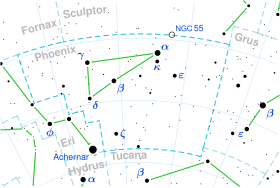Nu Phoenicis
Appearance
| Observation data Epoch J2000 Equinox J2000 | |
|---|---|
| Constellation | Phoenix |
| Right ascension | 01h 15m 11.12150s[1] |
| Declination | –45° 31′ 53.9954″[1] |
| Apparent magnitude (V) | 4.95[2] |
| Characteristics | |
| Spectral type | F9 V Fe+0.4[3] |
| U−B color index | +0.09[2] |
| B−V color index | +0.57[2] |
| Astrometry | |
| Radial velocity (Rv) | +11.7[4] km/s |
| Proper motion (μ) | RA: 665.13 ± 0.20[1] mas/yr Dec.: 177.63 ± 0.19[1] mas/yr |
| Parallax (π) | 66.16 ± 0.24 mas[1] |
| Distance | 49.3 ± 0.2 ly (15.11 ± 0.05 pc) |
| Absolute magnitude (MV) | 4.28[5] |
| Details | |
| Mass | 1.20−1.25[6] M☉ |
| Radius | 1.25[7] R☉ |
| Surface gravity (log g) | 4.30[3] cgs |
| Temperature | 6,069[3] K |
| Metallicity [Fe/H] | +0.02[3] dex |
| Rotational velocity (v sin i) | 3.7[7] km/s |
| Age | 5.7[5] Gyr |
| Other designations | |
| Database references | |
| SIMBAD | data |
Nu Phoenicis is a F-type main-sequence star in the southern constellation of Phoenix. It is visible to the naked eye with an apparent visual magnitude of 4.95.[2] This is a solar analogue, meaning its observed properties appear similar to the Sun, although it is somewhat more massive. At an estimated distance of around 49 light years,[1] this star is located relatively near the Sun.
Based on observations of excess infrared radiation from this star, it may possess a dust ring that extends outward several AU from an inner edge starting at 10 AU.[9]
See also
References
- ^ a b c d e f van Leeuwen, F. (November 2007), "Validation of the new Hipparcos reduction", Astronomy and Astrophysics, 474 (2): 653–664, arXiv:0708.1752, Bibcode:2007A&A...474..653V, doi:10.1051/0004-6361:20078357.
- ^ a b c d Mermilliod, J.-C. (1986), "Compilation of Eggen's UBV data, transformed to UBV (unpublished)", Catalogue of Eggen's UBV data. SIMBAD, Bibcode:1986EgUBV........0M.
- ^ a b c d Gray, R. O.; et al. (July 2006), "Contributions to the Nearby Stars (NStars) Project: spectroscopy of stars earlier than M0 within 40 pc-The Southern Sample", The Astronomical Journal, 132 (1): 161–170, arXiv:astro-ph/0603770, Bibcode:2006AJ....132..161G, doi:10.1086/504637.
- ^ Holmberg, J.; et al. (July 2009), "The Geneva-Copenhagen survey of the solar neighbourhood. III. Improved distances, ages, and kinematics", Astronomy and Astrophysics, 501 (3): 941–947, arXiv:0811.3982, Bibcode:2009A&A...501..941H, doi:10.1051/0004-6361/200811191.
- ^ a b Mamajek, Eric E.; Hillenbrand, Lynne A. (November 2008). "Improved Age Estimation for Solar-Type Dwarfs Using Activity-Rotation Diagnostics". The Astrophysical Journal. 687 (2): 1264–1293. arXiv:0807.1686. Bibcode:2008ApJ...687.1264M. doi:10.1086/591785.
- ^ Sousa, S.G.; et al. (2006), "Spectroscopic parameters for a sample of metal-rich solar-type stars", Astronomy and Astrophysics, 458 (3): 873–880, Bibcode:2006A&A...458..873S, doi:10.1051/0004-6361:20065658.
- ^ a b Fuhrmann, K.; Chini, R. (2012), "Multiplicity among F-type Stars", The Astrophysical Journal Supplement, 203 (2): 20, Bibcode:2012ApJS..203...30F, doi:10.1088/0067-0049/203/2/30, 30.
- ^ "nu. Phe -- High proper-motion Star", SIMBAD Astronomical Database, Centre de Données astronomiques de Strasbourg, retrieved 2015-12-22.
- ^ Beichman, C. A.; Tanner, A.; Bryden, G.; Stapelfeldt, K. R.; et al. (2006). "IRS Spectra of Solar-Type Stars: A Search for Asteroid Belt Analogs". Astrophysical Journal. 639 (2): 1166–1176. arXiv:astro-ph/0601467. Bibcode:2006ApJ...639.1166B. doi:10.1086/499424.
External links
- "HD 7570 -- High proper-motion Star". Simbad. Retrieved 2006-08-01.
- "4C00106". ARICNS. Archived from the original on January 18, 2005. Retrieved 2006-08-01.
{{cite web}}: Unknown parameter|deadurl=ignored (|url-status=suggested) (help)

